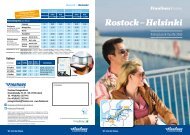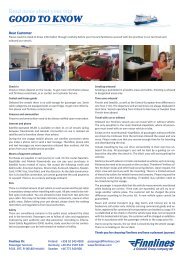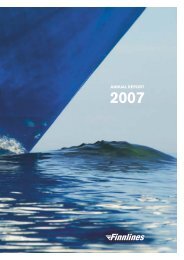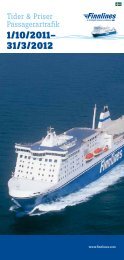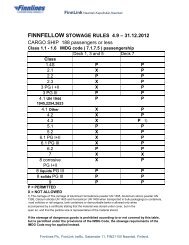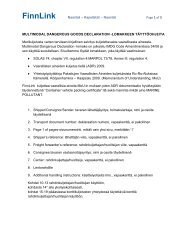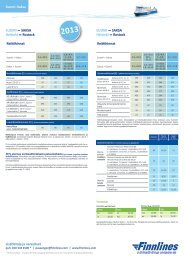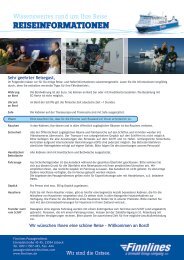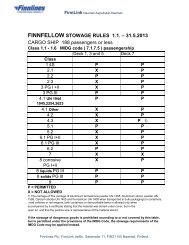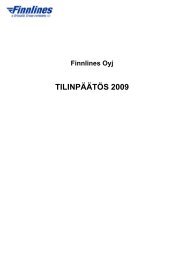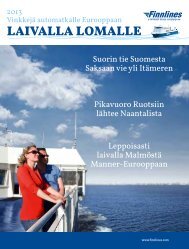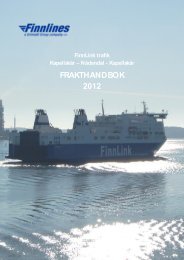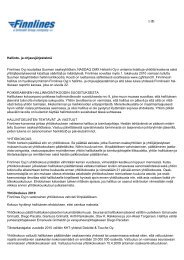FINANCIAL STATEMENTS 2010 - Finnlines
FINANCIAL STATEMENTS 2010 - Finnlines
FINANCIAL STATEMENTS 2010 - Finnlines
Create successful ePaper yourself
Turn your PDF publications into a flip-book with our unique Google optimized e-Paper software.
PARENT COMPANY ACCOUNTING PRINCIPLES <strong>2010</strong><br />
The financial statements are prepared in conformity with the<br />
Finnish Accountancy Act and other regulations and provisions in<br />
force in Finland.<br />
REVENUES<br />
Revenues comprise sales income and exchange rate differenc-<br />
es related to sales, excluding discounts and indirect sales taxes<br />
such as VAT.<br />
OTHER OPERATING INCOME<br />
Other operating income includes profits on the sale of property<br />
and other fixed assets as well as other regular income not directly<br />
related to the company's sales, such as rents and leases.<br />
FOREIGN CURRENCY ITEMS<br />
Receivables and payables denominated in foreign currencies<br />
are valued at the exchange rates prevailing on the balance sheet<br />
date. Exchange rate differences on accounts receivable are rec-<br />
ognised under revenue and exchange rate differences on ac-<br />
counts payable under operating expenses. Exchange rate dif-<br />
ferences on financing operations are recognised under financial<br />
items.<br />
DERIVATIVE <strong>FINANCIAL</strong> INSTRUMENTS<br />
The realised gains and losses arising from derivative financial<br />
instruments such as forward foreign exchange and option con-<br />
tracts and currency swaps are recognised under financial items.<br />
The interest received or payable under derivative financial instru-<br />
ments used to hedge the company against interest rate risks is<br />
accrued over the duration of the contract and recorded as an ad-<br />
justment to the interest income or expenses of the designated as-<br />
set or liability.<br />
<strong>Finnlines</strong> also covers itself against changes in fuel prices by<br />
including bunker clauses in its freight contracts.<br />
FIXED ASSETS AND DEPRECIATION<br />
Fixed assets are capitalised to their direct acquisition cost ex-<br />
cluding depreciation and other deductions, along with any revalu-<br />
ations allowed by local accounting practices. Fixed assets sub-<br />
ject to wear and tear are depreciated according to plan based<br />
on the economic life span of the asset and its estimated residual<br />
value.<br />
Depreciation periods:<br />
Vessels 30-35 years<br />
Buildings 10-40 years<br />
Constructions 5-10 years<br />
Stevedoring machinery and equipment 5-25 years<br />
Other machinery and equipment 3-10 years<br />
Other long-term expenditure 3-20 years<br />
Second-hand vessels are depreciated over their estimated eco-<br />
nomic service life.<br />
LEASING<br />
56 FINNLINES PLC Financial Statements <strong>2010</strong> (figures in EUR thousand, if not stated otherwise)<br />
Leasing payments are recognised as expenses regardless of the<br />
form of leasing.<br />
INVENTORIES<br />
Vessel stocks of fuel, lubricating oil, materials, provisions and<br />
sales items are recognised under stocks. Stocks are valued on<br />
a first-in, first-out basis at their direct acquisition cost or lower<br />
probable net realisable value.<br />
<strong>FINANCIAL</strong> ASSETS<br />
The part of the financial assets that have been invested in money<br />
market instruments are included in the financial assets in the bal-<br />
ance sheet. The financial assets with a maturity longer than one<br />
year, are valued at the lower of acquisition cost or fair value on<br />
the balance sheet date.<br />
PENSION COSTS<br />
Pension costs are charged to the profit and loss account accord-<br />
ing to the local practice. The entire uncovered pension liability is<br />
recorded as an expense and liability.<br />
EXTRAORDINARY ITEMS<br />
Extraordinary income and expenses are group contributions re-<br />
ceived and given.<br />
PROVISIONS<br />
Expenses and losses that no longer accrue corresponding reve-<br />
nues in the foreseeable future and that the company is committed<br />
or obliged to settle and whose monetary value can reasonably be<br />
assessed are recognised as expenses in the profit and loss ac-<br />
count, and included as a provision in the balance sheet.



